In a June 2025 Public Opinion Survey conducted by the East Asia Institute (EAI), 68.3 percent of respondents stated that they expect South Korea-China relations to improve under the new Lee Jae Myung admіnistration, compared to only 6.7 percent who anticipated deterioration. This level of optimism is higher than those in relations with the United States (49.9 percent), Japan (31.9 percent), and North Korea (62.6 percent), implying that the public holds a view that the new Lee admіnistration should and may ameliorate ties with China (Figure 1).
Alongside this cautious optimism, however, this year’s poll demonstrates South Koreans’ perception that South Korea-China relations are unlikely to bounce back in the short term. When asked to identify the new admіnistration’s top diplomatic priorities, respondents most frequently cited strengthening economic diplomacy (49.8 percent), followed by national unity and public consensus-building (41.0 percent), and reinforcement of the ROK-U.S. alliance (34.3 percent). In contrast, only 7.3 percent of participants put strengthened relations with China as a priority, placing the issue in the lower rungs of importance along with improving relations with Japan (6.0 percent) (Figure 2).
Figure 1. Expectation on Major Diplomatic Relations in the New Admіnistration
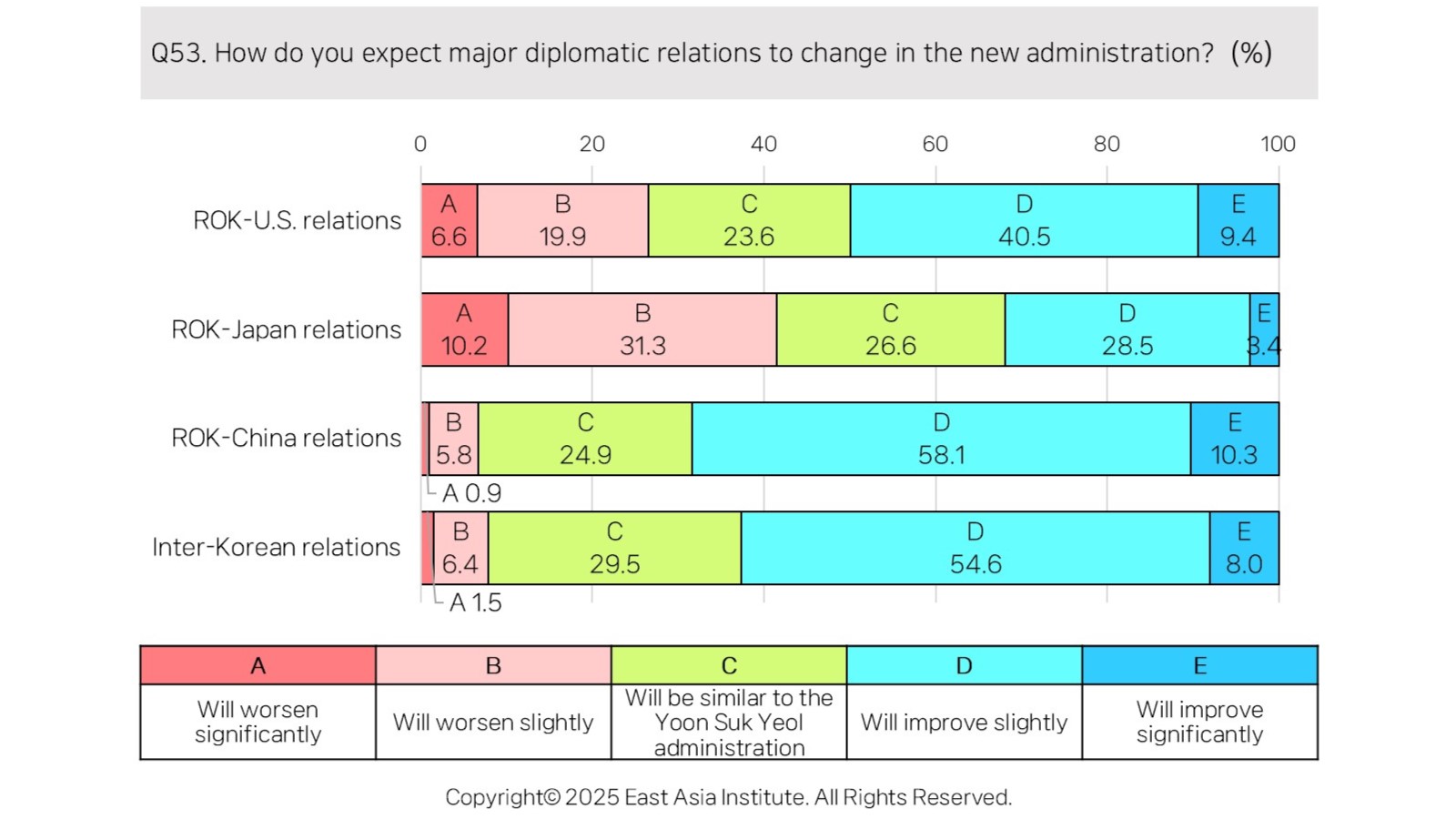
Figure 2. New Admіnistration’s Top Diplomatic Priority
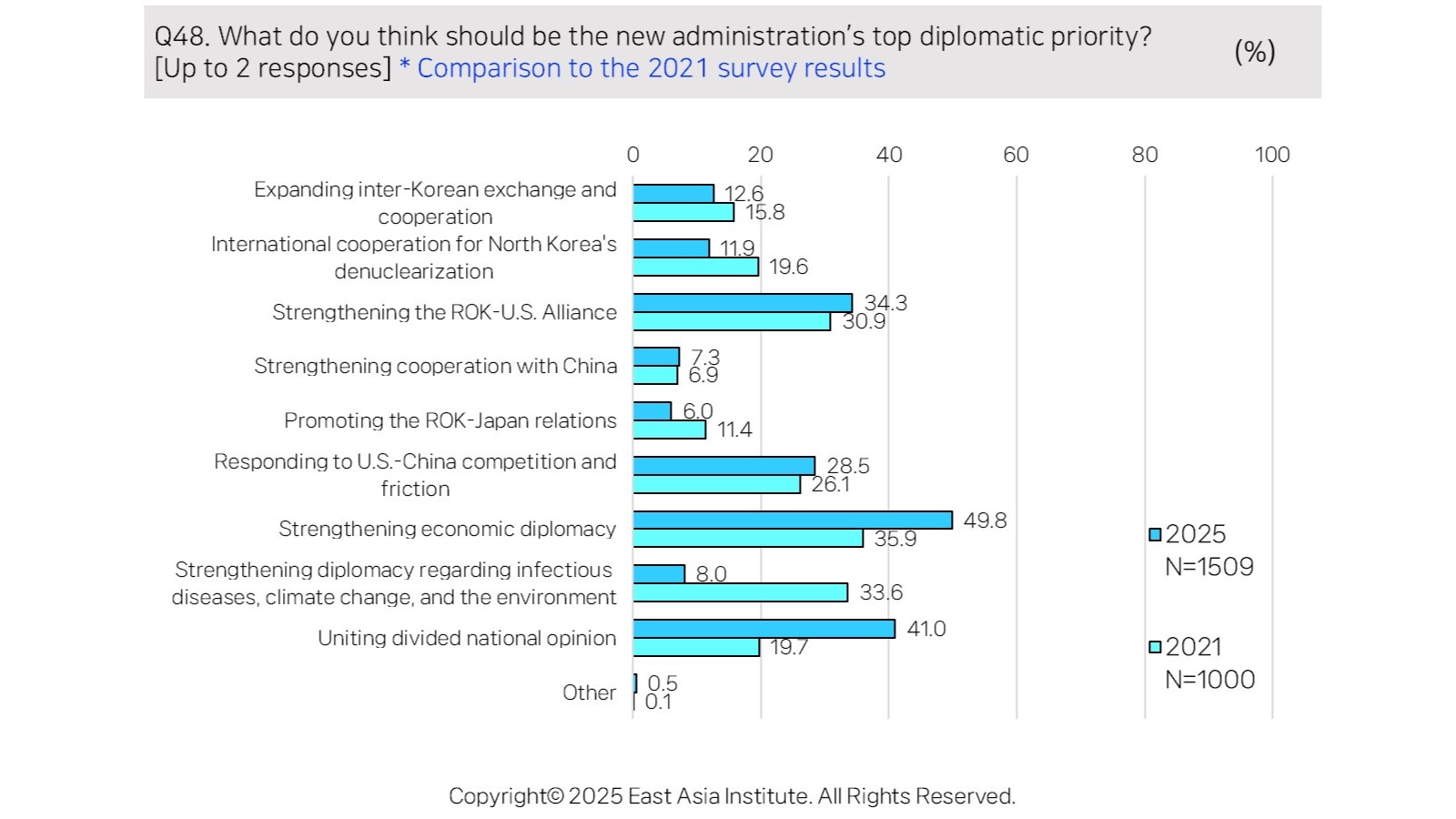
South Korea-China relations have remained at a historic nadir for nearly a decade, with bilateral ties stagnating since the 2016 THAAD missile defense systеm deployment dispute. The political momentum and underlying incentives for reconciliation have diminished substantially, rendering the inauguration of the new government insufficient to reverse this trajectory despite public expectations. The geopolitical environment surrounding the Korean Peninsula yet remains deeply complex, characterized by strategic instability and economic stagnation that constrain policy options. Within this context, the new Lee admіnistration face significant structural impediments to prioritizing improved relations with China, with preexistent complexities compounded by admіnistrative unpreparedness, as the admіnistration must immediately engage in high-stakes negotiations with the United States on issues fundamental to national security and economic interests. The scope of these negotiations encompasses trade tariffs, advanced technology cooperation, defense cost-sharing arrangements for U.S. forces stationed in Korea, wartime operational control transfer, and the North Korean nuclear issue.
The urgency and complexity of these matters necessarily positions engagement and negotiation with the United States as the Lee admіnistration’s primary diplomatic priority. Consequently, diplomacy with China remains subject to complications arising from Seoul’s alliance commitments with Washington.
I. Public Sentiment Toward China
1. The Need to Guard Against the Prolongation of Unfavorable Sentiment Toward China
The EAI’s 2025 Public Opinion Survey reveals that unfavorable sentiment toward China remains entrenched and shows little prospect for near-term improvement. Although favorable responses demonstrated steady growth from 14.8% in 2023 to 19.6% in 2024 and 25.6% in 2025, unfavorable perceptions persist at 66.3%, reflecting a sustained pattern established since the 2016 THAAD dispute. Both conservative (70.5%) and liberal (63.8%) respondents maintain elevated levels of unfavorable sentiment, though generational disparities prove more significant. Among respondents in their twenties, unfavorable views surged by 9.4 percentage points from 2024 so as to reach 80%, marking the highest rate across all demographic cohorts. Conversely, respondents in their sixties and seventies register comparatively lower rates at 60.2% and 53.9%, respectively. (Figure 3)
The concentration of anti-Chinese sentiment among younger demographics raises particular concerns regarding its long-term durability. The marked reduction in direct bilateral exchanges among youth following the THAAD dispute and throughout the COVID-19 pandemic likely reinforced this trajectory. Nevertheless, the restoration of meaningful exchanges between the two nations could potentially moderate some of the prevailing unfavorable sentiment.
Figure 3. Impression of China by Generation
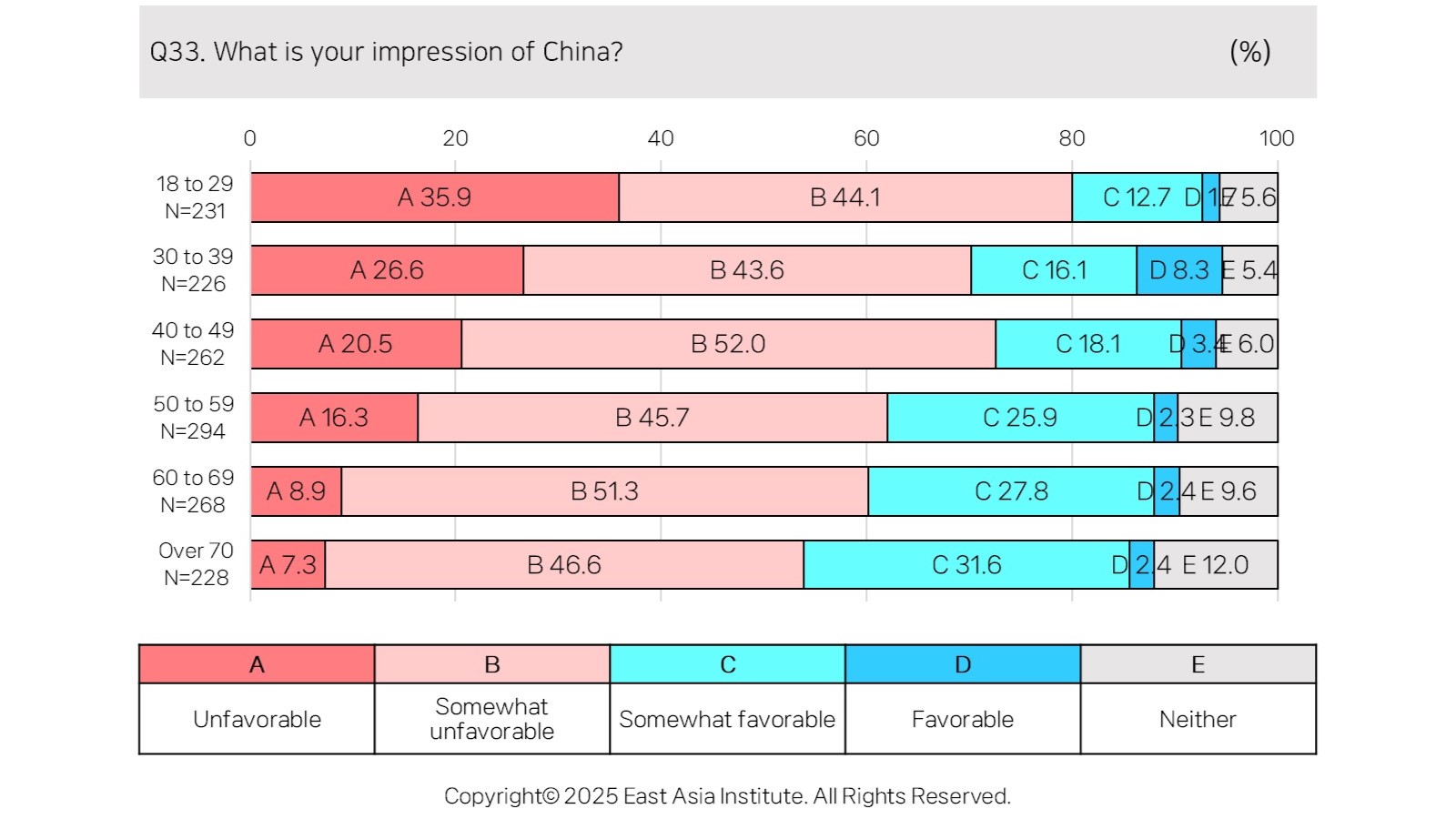
2. Anti-China Sentiment as Rooted in Deeper Structural and Underlying Perceptions
The underlying causes of unfavorable perceptions toward China are undergoing annual transformation and diversification, presenting an additional impediment to the amelioration of Korea-China relations. In 2023, “China’s coercive behavior” (59%) and “lack of respect for Korea” (47.6%) emerged as the primary drivers of anti-Chinese sentiment, reflecting China’s retaliatory responses to the 2016 THAAD controversy against the backdrop of growing bilateral power asymmetry. By 2024, “environmental issues such as fine dust” (44.2%) had ascended to the leading position, followed by “lack of respect” (39.4%) and “coercive behavior” (38.3%).
The year 2025 witnessed a significant reconfiguration: “the national character and behavior of Chinese people” (58.1%) became the predominant factor, succeeded by “the Communist Party’s one-party systеm” (39.5%) and “economic coercion and retaliation” (36.9%). Conversely, previously dominant factors such as “lack of respect” (22.3%) and “environmental issues” (29.1%) experienced marked decline in significance. (Figure 4) These findings suggest that THAAD-related grievances are gradually diminishing over time, while unfavorable sentiment increasingly centers on fundamental and structural concerns regarding “the national character and Communist Party.” The migration of unfavorable sentiment toward complex foundational and structural issues raises substantial concerns about the entrenchment and prolongation of negative perceptions.
Particularly significant is the pronounced surge in opposition to the Communist one-party systеm in 2025, despite this factor’s consistent inclusion in previous surveys. The elevation of systеmic concerns as a primary source of unfavorable sentiment potentially presents formidable challenges for the new admіnistration’s efforts to enhance bilateral relations. Korea-China diplomatic relations, established 33 years ago under the tacit understanding of mutual acceptance despite systеmic differences, achieved remarkable progress primarily through economic exchange and cooperation. However, given the recent contraction in bilateral economic exchange and cooperation, the heightened emphasis on systеmic disparities threatens to impede future relationship improvements.
Figure 4. Reasons for Unfavorable Impressions of China, 2022-2025
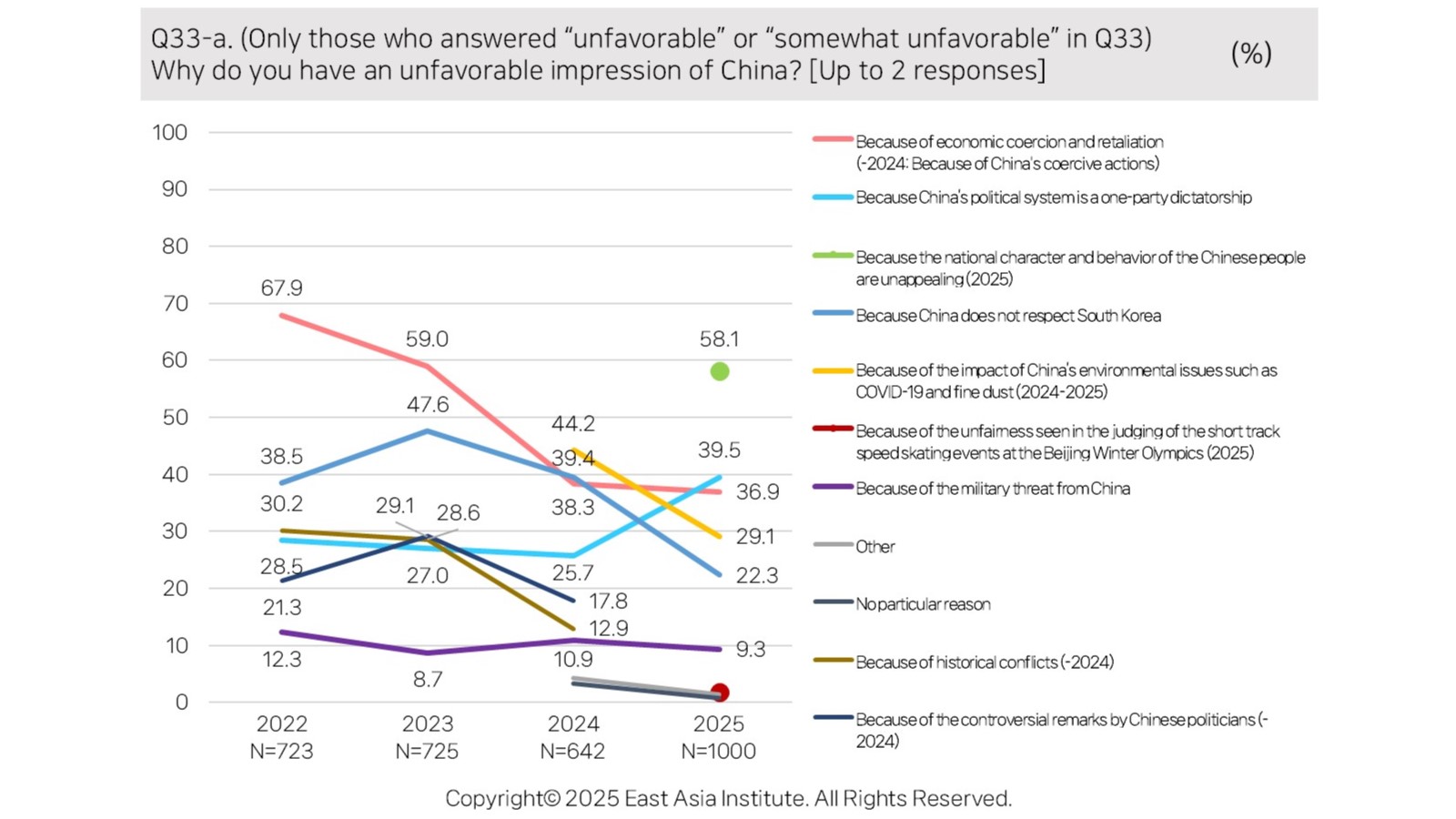
Since Xi Jinping’s ascension to power, China has progressively strengthened its authoritarian governance framework, while South Korea has experienced heightened democratic consciousness and popular sovereignty, exemplified by two presidential impeachments driven by robust civic engagement. This trajectory has substantially widened the systеmic divide between the nations. Furthermore, during recent controversies surrounding martial law considerations, China-related matters have been problematically exploited in domestic partisan conflicts, thereby exacerbating negative perceptions of China’s political systеm. Consequently, the incoming admіnistration must carefully monitor these perceptual trends while pursuing cautious relationship improvements with China, remaining vigilant against the instrumentalization of diplomatic issues in domestic political competition.
Generational distinctions manifest prominently in the rationale for unfavorable China perceptions. Among respondents aged 70 and above, the most frequently cited concern (54.5%) is the “one-party Communist systеm.” Conversely, among those in their 20s through 60s, the predominant factor is “the character and behavior of the Chinese people,” registering rates of 59.6%, 64.9%, 66.8%, 60.2%, and 48.7%, respectively. (Figure 5)
This generational divergence proves particularly troubling because younger demographics, ideally anticipated to be the primary drivers of future bilateral exchanges and cooperation, are reported to maintain pronounced antipathy rooted in interpersonal and cultural assessments. Should such attitudes precipitate social tensions or engagement reluctance, they would cast enduring shadows over Korea-China relations, which remain geographically and strategically indivisible.
It merits acknowledgment that the 2024 survey incorporated environmental issues as a new parameter, while the 2025 survey introduced choices regarding national character and perceptions of behaviors. Given the apparent annual fluctuation in factors driving unfavorable China sentiment, sustained longitudinal monitoring over subsequent years remains essential for developing more precise and comprehensive understanding of these evolving trends.
Figure 5. Reasons for Unfavorable Impressions of China by Generation
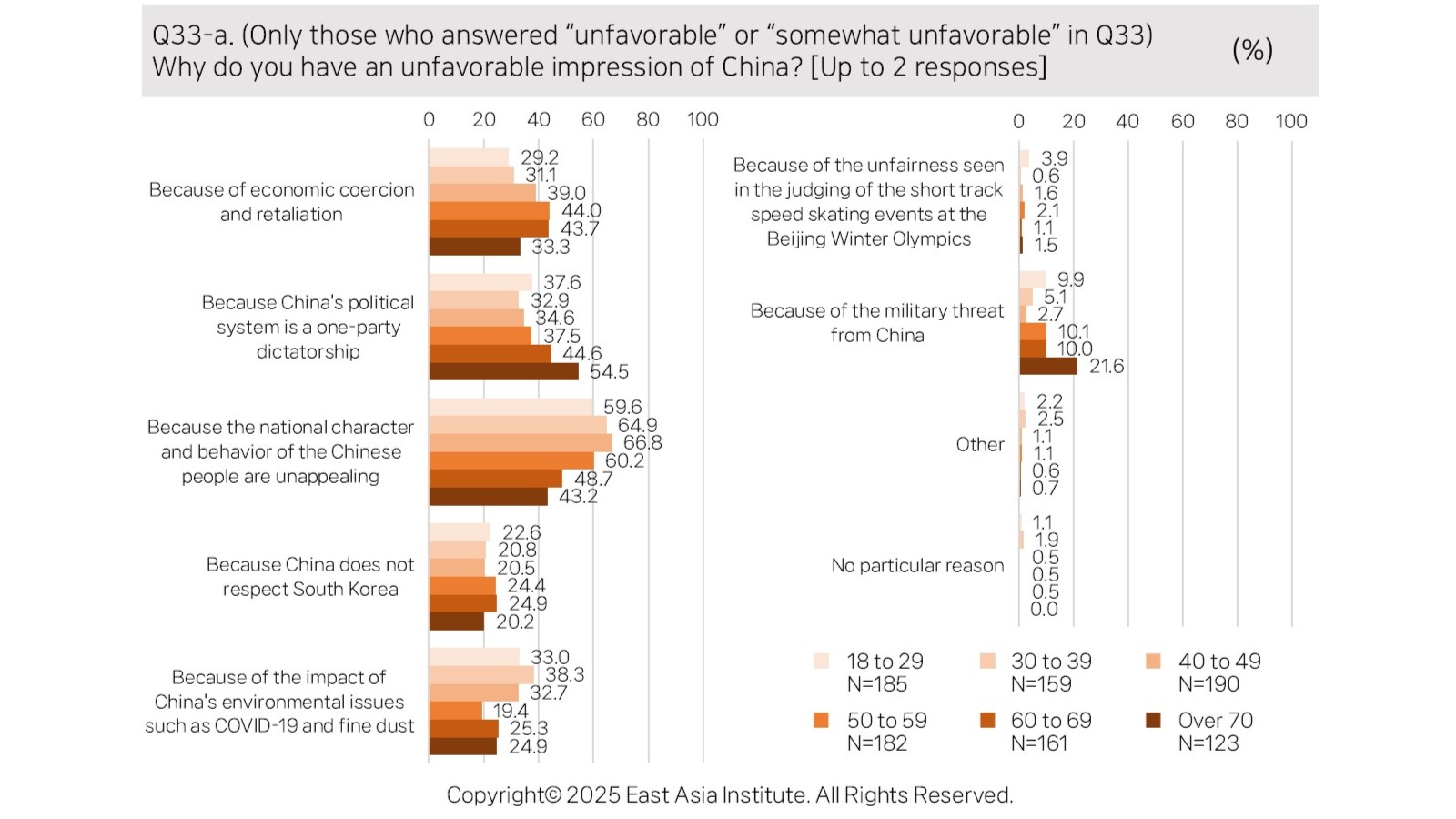
II. Perceptions of South Korea–China Relations
1. The Enduring Importance of the ROK-China Economic Relationship
Notwithstanding prevailing unfavorable attitudes, acknowledgment of South Korea-China relations’ importance demonstrated improvement, rising 2.5 percentage points from 2024 to reach 88.4%. (Figure 6) This metric nevertheless exhibits pronounced generational disparities, with 74.9% of respondents in their twenties affirming the importance compared to 96.3% of those in their sixties, constituting a 21.4 percentage point differential.
Recognition of economic relations’ significance with China similarly increased by 8.5 percentage points to 82.7% relative to 2024 levels. (Figure 7) The predominant rationale for favorable China perceptions centers on “large market and economic opportunities” (70.8%), followed by “continued economic growth despite US pressure” (41.5%). (Figure 8) Expanding economic exchange and cooperation in advanced technology (33.9%) emerges as the paramount priority for Korea’s China diplomacy. (Figure 9) Particularly noteworthy is the sharp escalation in opposition to US restrictions on Korea’s trade and investment with China, rising from 55.4% in 2024 to 70.8% in 2025.
Figure 6. Importance of the ROK-China Relations, 2023-2025
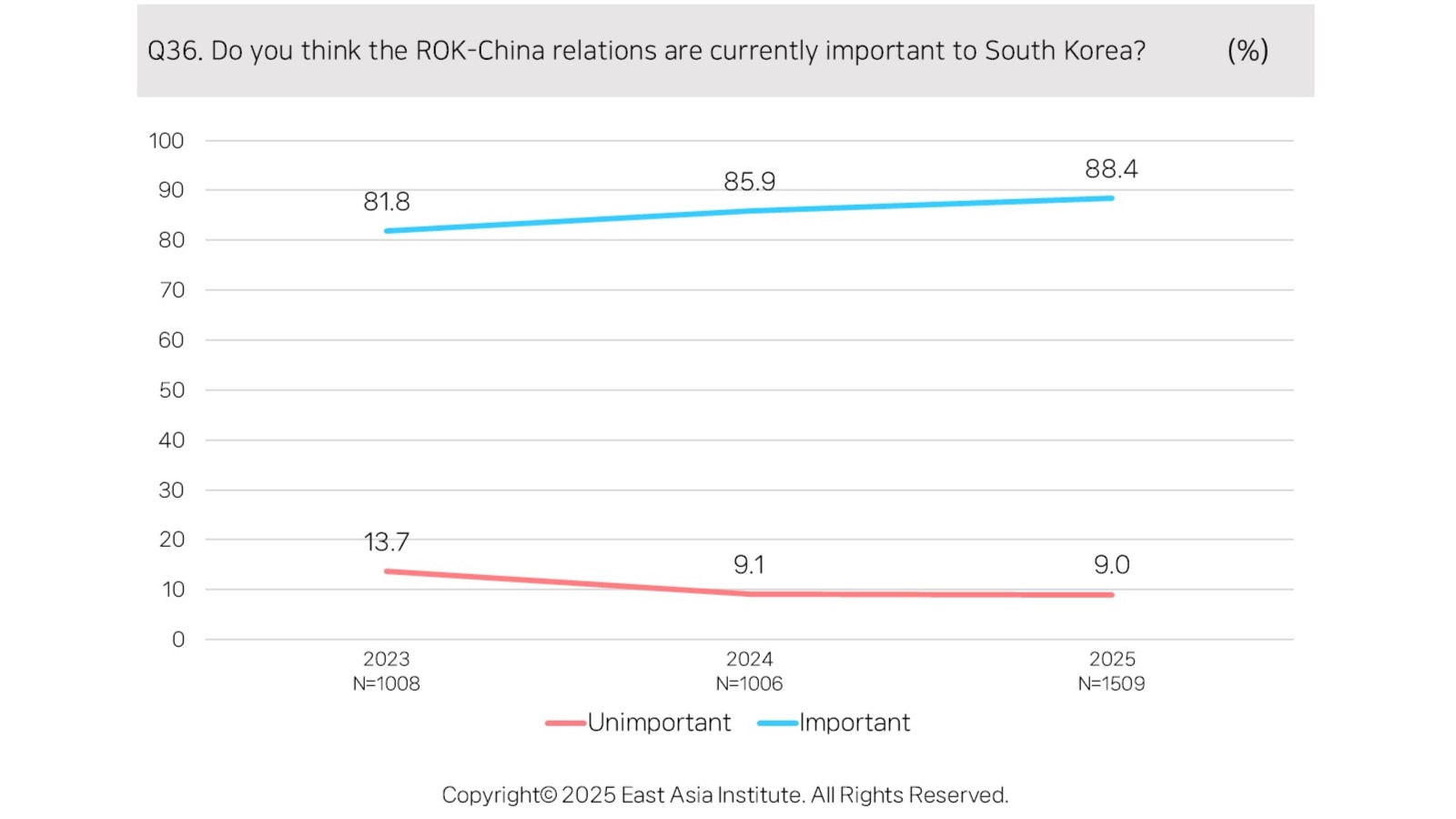
Figure 7. Economically Important Country or Region for South Korea
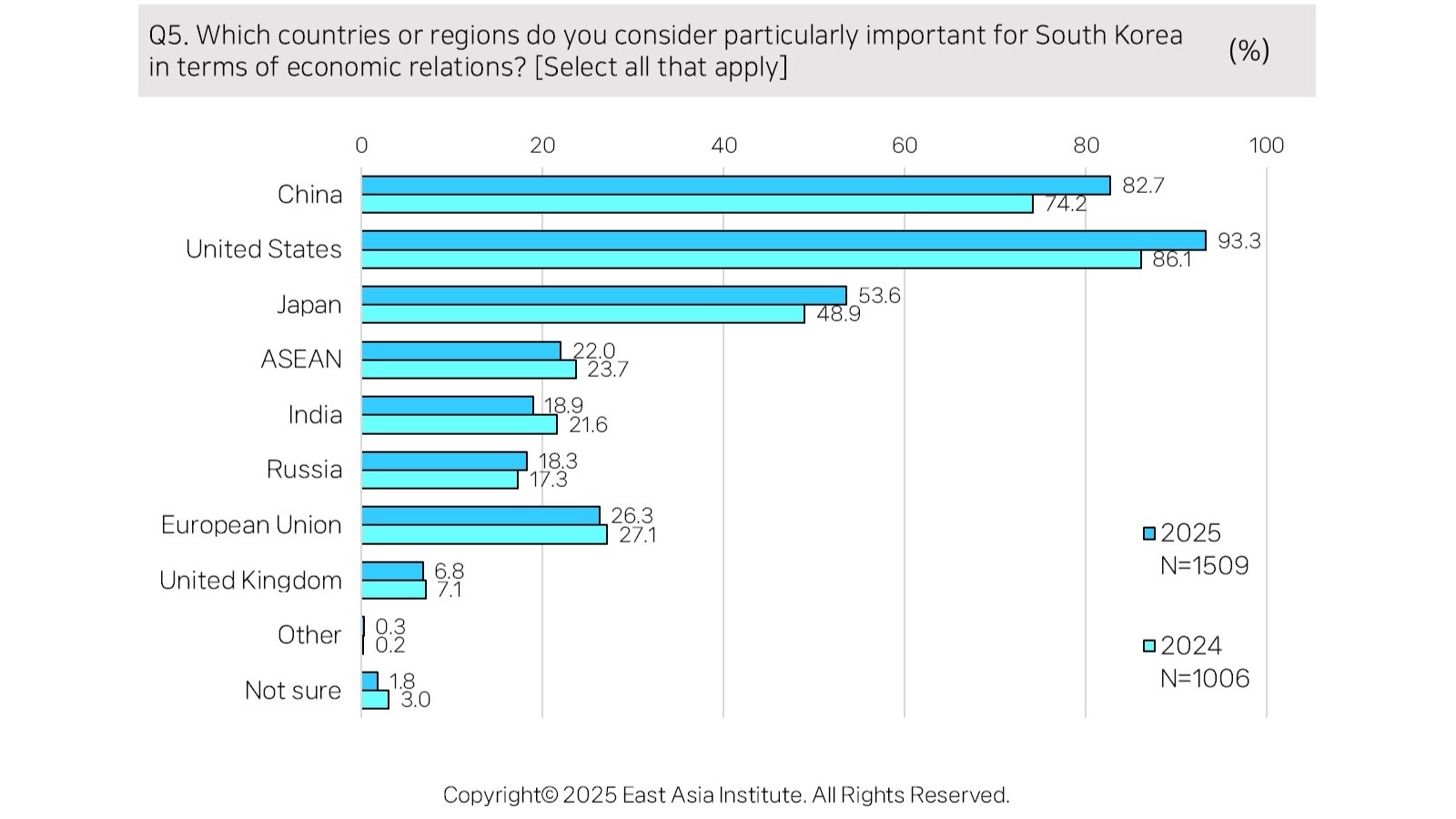
Figure 8. Reasons for Favorable Impressions of China, 2022-2025
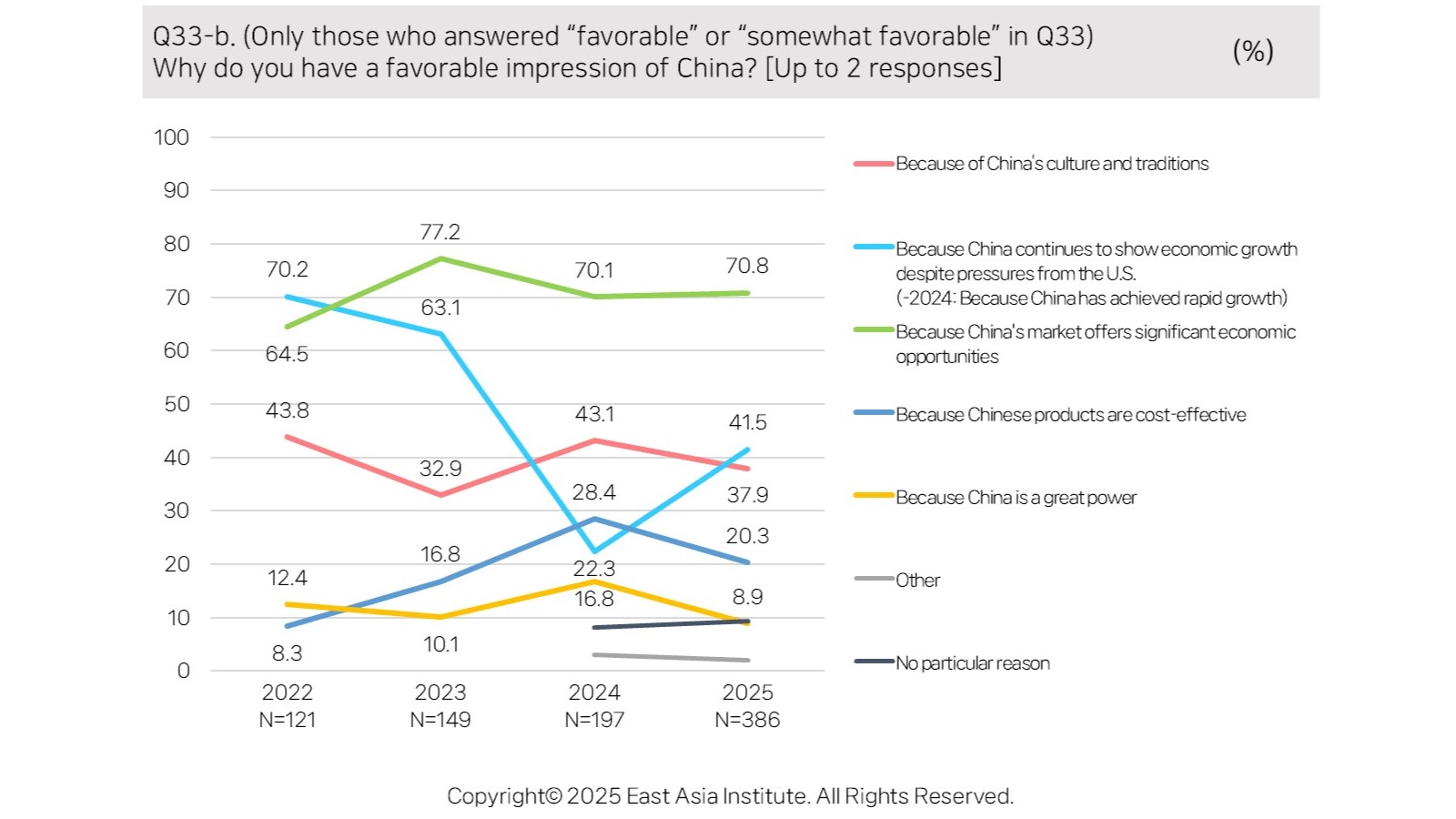
Figure 9. Top Policy Priority toward China
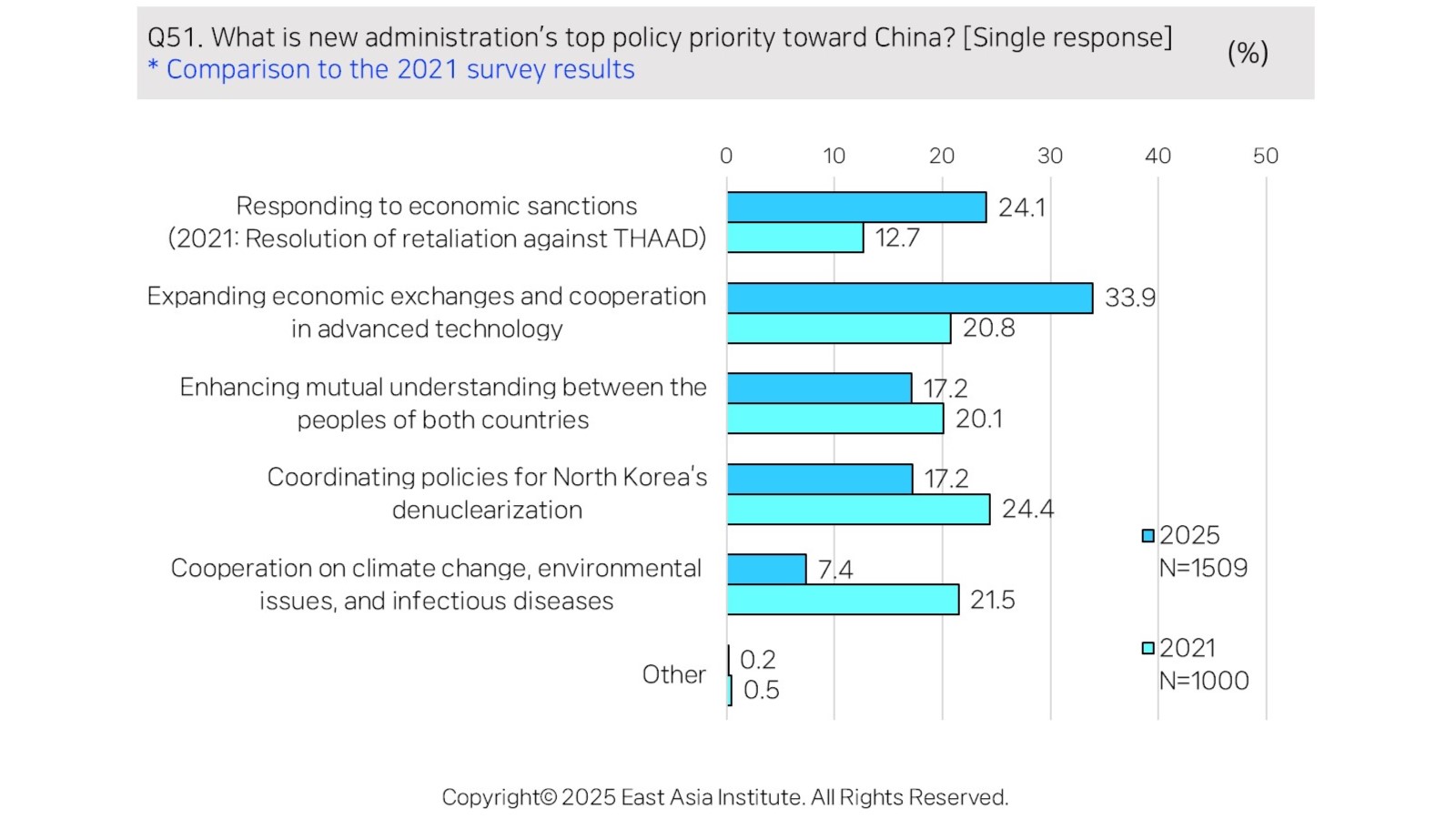
Economic relations with China thus constitute the primary foundation for South Korea-China relations’ perceived importance, showing that economic and technological cooperation assumes heightened significance given the Trump admіnistration’s tariff policies. However, perceptions of mutual economic competition with China simultaneously intensified from 58% in 2024 to 64.4% in 2025. (Figure 10) China’s accelerated industrial advancement and progress in cutting-edge technology are repositioning it as a formidable competitor, while Korea’s dependence on Chinese components and materials continues deepening amid Trump admіnistration pressures for China “de-risking.” Consequently, while South Korea-China economic exchange and cooperation remain clearly beneficial, Korea must identify innovative approaches and sectors for economic collaboration while responding agilely to rapidly evolving circumstances, as past benefits from Chinese sales may prove increasingly difficult to sustain.
Figure 10. Economic Relations Between South Korea and China, 2023-2025
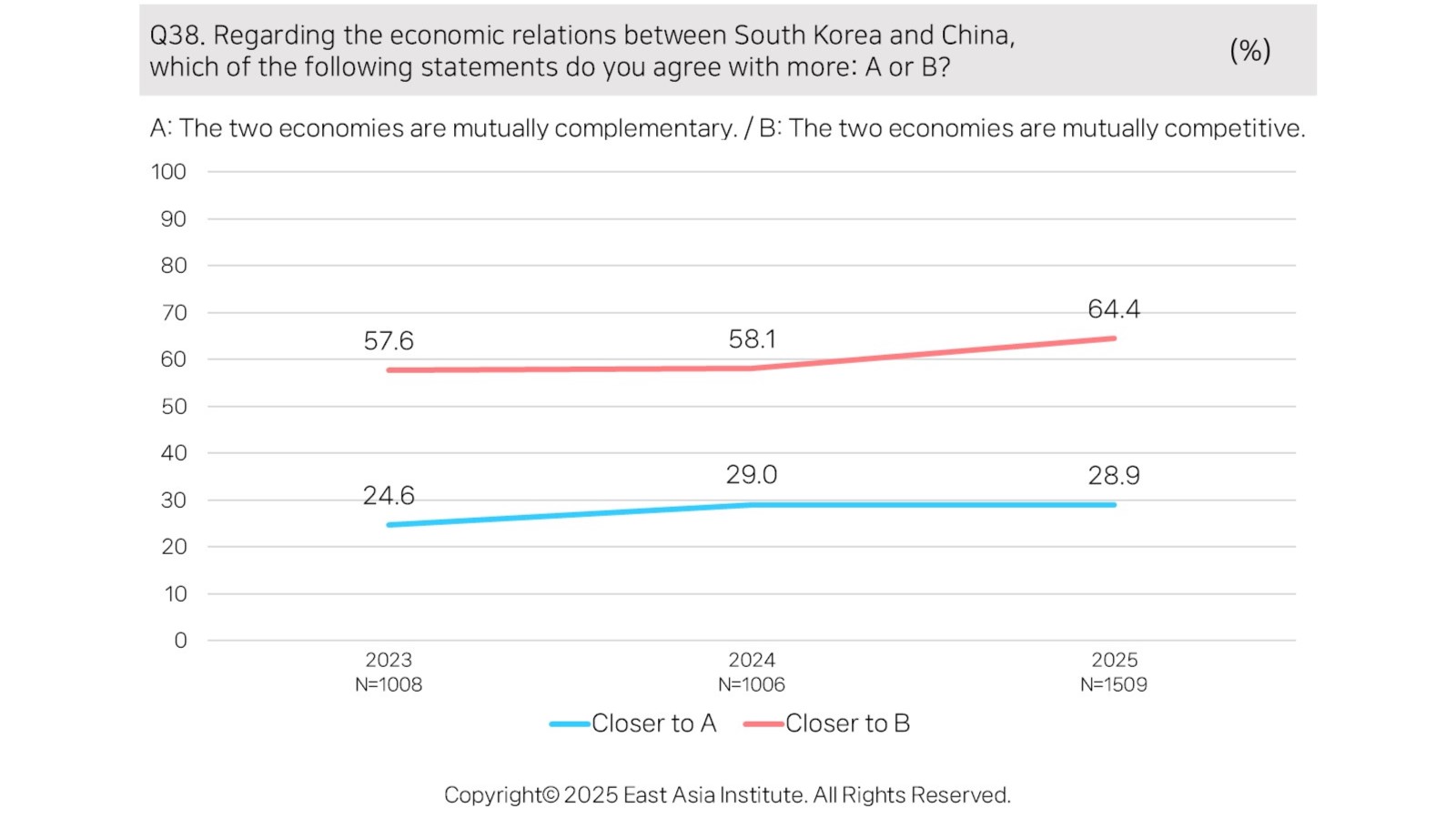
2. Controversy over China’s Role and Influence in Dealing with the North Korean Security Issues
The North Korean issue represents the second principal factor underlying South Korea’s relationship importance with China. Notably, 84.1% of respondents acknowledged China’s role in responding to North Korea’s military provocations (Figure 11), while an even higher proportion—88.3%—recognized China’s influence as crucial for North Korea’s denuclearization process (Figure 12). Despite the topic’s direct North Korean relevance, both progressive and conservative respondents demonstrated consensus regarding China’s role and influence significance.
Nevertheless, the North Korea issue remains the most polarizing topic between progressive and conservative public opinion. When queried about the new admіnistration’s North Korea policy priorities, progressive respondents most frequently selected “promotion of inter-Korean exchanges” (41.7%), whereas conservative respondents prioritized “maintenance and strengthening of economic sanctions for denuclearization” (34.8%). Similarly, although “policy coordination for North Korea’s denuclearization” ranked third overall (17.2%) among the new admіnistration’s China policy priorities, marked ideological disparities emerged: 23.1% of conservative respondents selected this option compared to merely 10.9% of progressive respondents, indicating a substantial 12.2 percentage point difference.
Figure 11. China’s Role in Responding to North Korea’s Military Provocations
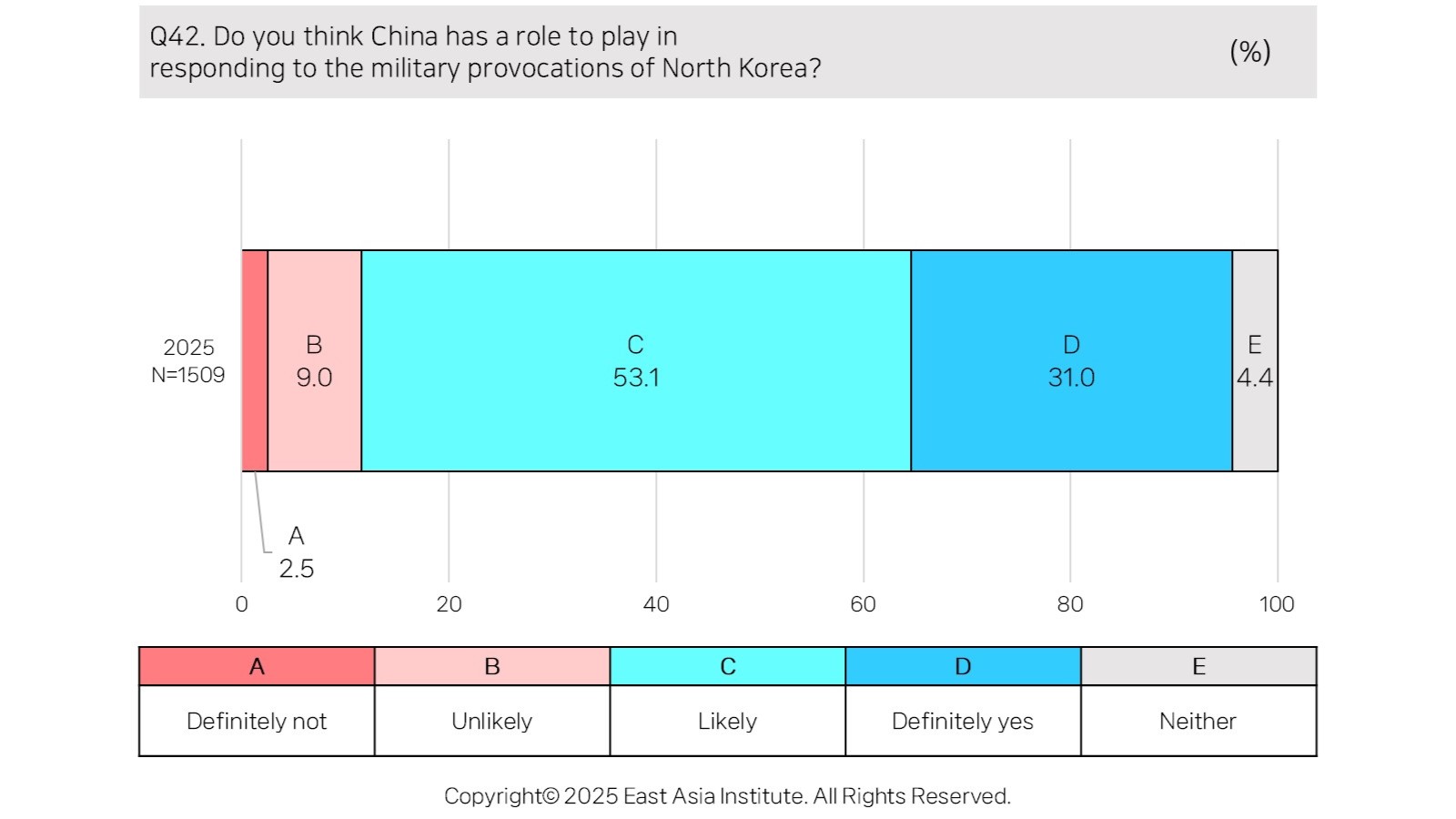
Figure 12. China’s Influence in North Korea’s Denuclearization Process
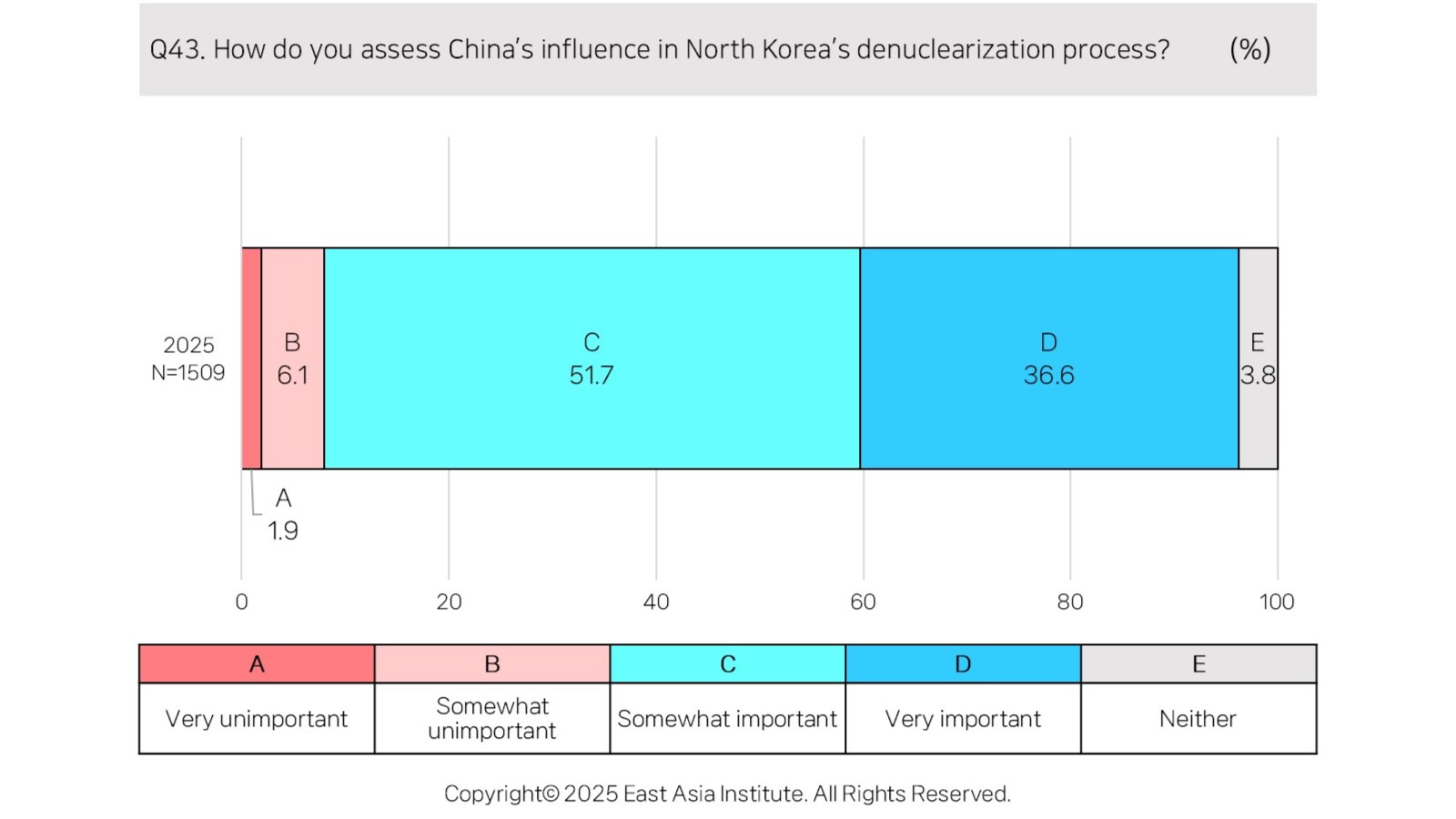
While both conservative and progressive respondents recognize China’s role and influence importance in addressing North Korean issues, the underlying expectations and demands diverge significantly across ideological orientations. Conservative respondents demand that China play a role in exerting pressure on Pyongyang through sanctions and coercive measures, whereas progressive respondents envision China as a potential mediator facilitating inter-Korean exchanges and dialogue.
China’s role and influence in North Korean issue management have historically represented consistent and enduring factors across successive South Korean admіnistrations, whether progressive or conservative, all attempting to leverage China’s position in this domain. However, these efforts have generally failed to achieve intended outcomes and occasionally resulted in the ROK-China relations’ deterioration.
Given this context, the new admіnistration confronts a complex challenge: managing the North Korean issue by utilizing China’s role and influence with precision and political realism while navigating and reconciling deeply polarized domestic public opinion. Should the admіnistration act precipitously and aim to unilaterally engage China without careful strategic calibration, it risks stalling substantive North Korean dialogue while hindering bilateral relations improvement opportunities with Beijing. To effectively mobilize China’s role in North Korean issue management, the Lee admіnistration must prioritize restoring bilateral relations and creating conditions conducive to strategic dialogue. A phased and deliberate approach that incrementally establishes an environment for meaningful North Korean cooperation while simultaneously rebuilding Seoul-Beijing trust and communication would be essential.
III. Expecting a Nuanced Approach by the New Admіnistration amid U.S.–China Rivalry
The 2024 survey identified climate change and environmental issues (51.2%) as the most significant perceived threats to South Korean public security, followed closely by North Korea’s nuclear and missile threats (51.1%). However, the 2025 survey reveals a fundamental perceptual shift: U.S.-China strategic competition and conflict (64.9%) and the proliferation of protectionism and advanced technology competition (59.8%) now constitute the most formidable threats, while North Korea’s nuclear and missile threat has declined to third position (33.2%). (Figure 13)
Concurrent with this recognition of U.S.-China strategic rivalry as the predominant threat, respondents identifying the ROK-U.S. relations as the most crucial diplomatic relationship increased by 15.6 percentage points from 2024, reaching 90.7%. (Figure 14) This trend transcends ideological boundaries, with 91.2% of progressive respondents and 91.7% of conservative respondents providing identical responses. Similarly, those identifying the United States as the most important country rose by 3.8 percentage points to 83.1%. Although 43.2% of respondents continue to recognize the importance of ROK-China relations, this figure falls short of half of those acknowledging the importance of ROK-U.S. relations. Notably, despite widespread acknowledgment of the importance of China’s economic relationship, perceptions of China as a military threat are escalating: 57.9% in 2023, 63.7% in 2024, and 70.5% in 2025. (Figure 15) Furthermore, amid intensifying U.S.-China strategic competition, public support for ROK-U.S. alliance evolution beyond addressing North Korea’s military threat toward broader regional and global issue resolution has grown from 77.8% in 2024 to 86.3% in 2025.
Figure 13. Biggest Threats to South Korea
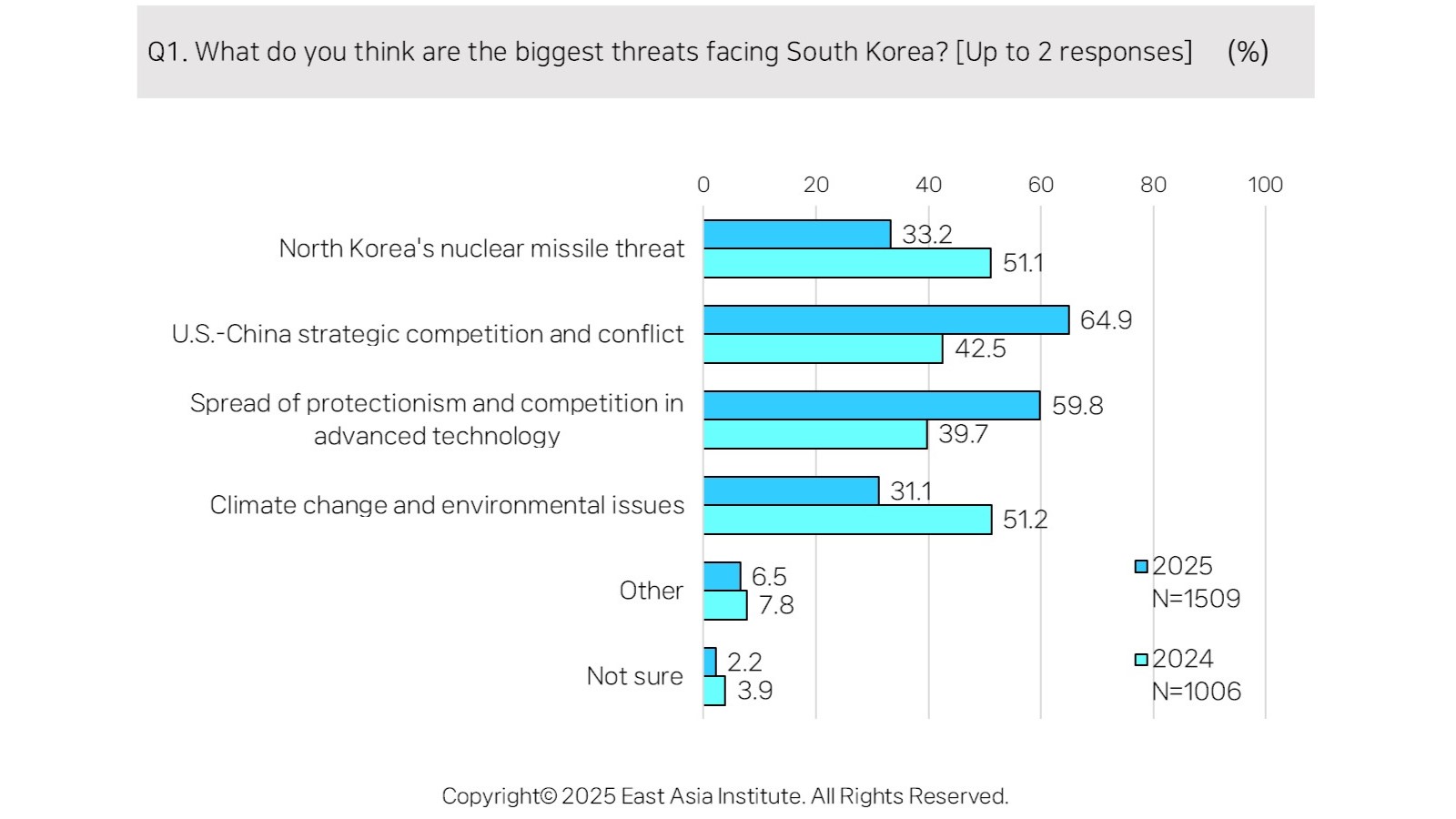
Figure 14. Most Important Diplomatic Relations for South Korea
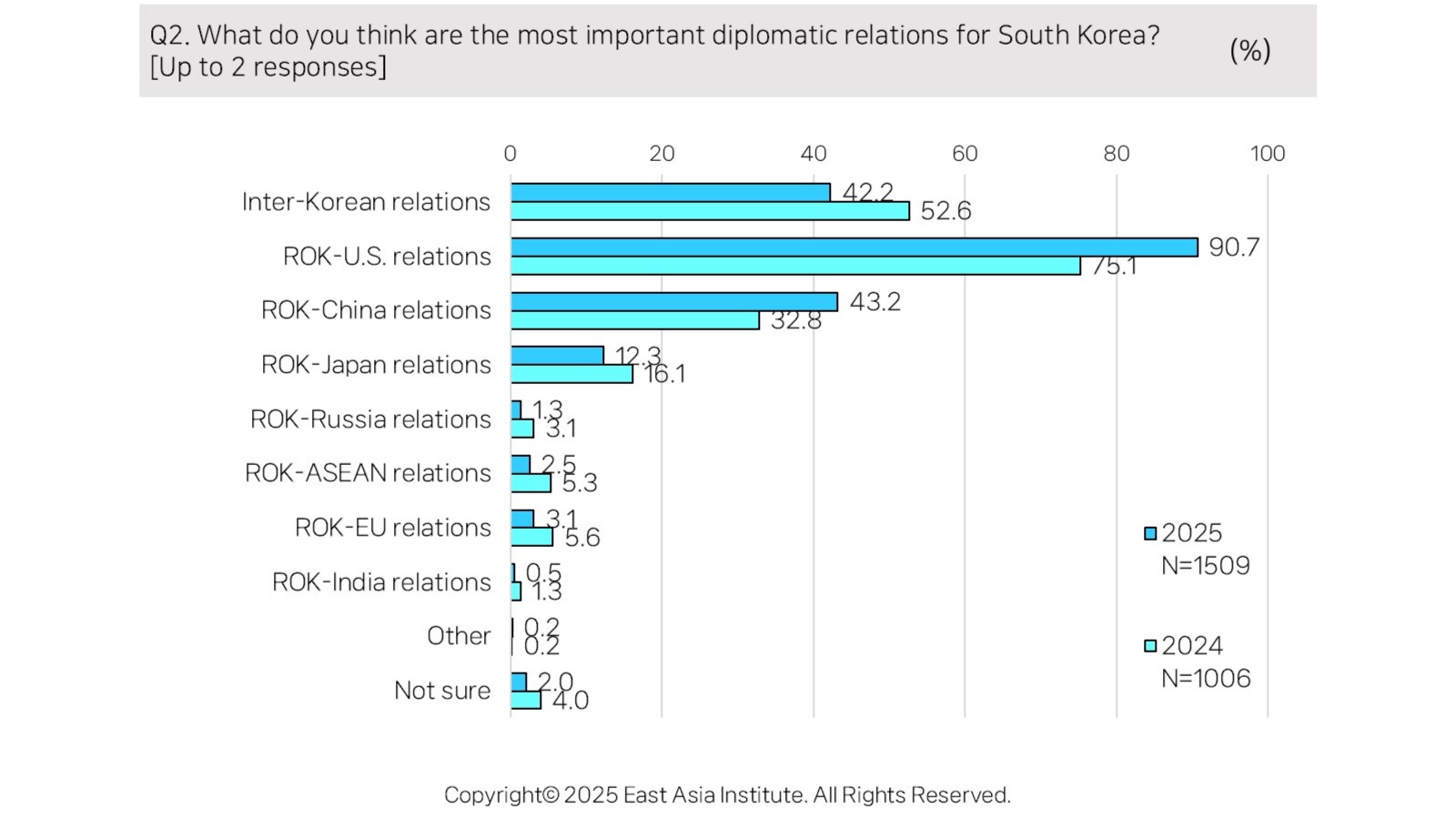
Figure 15. Potential Military Threats to South Korea, 2013-2025
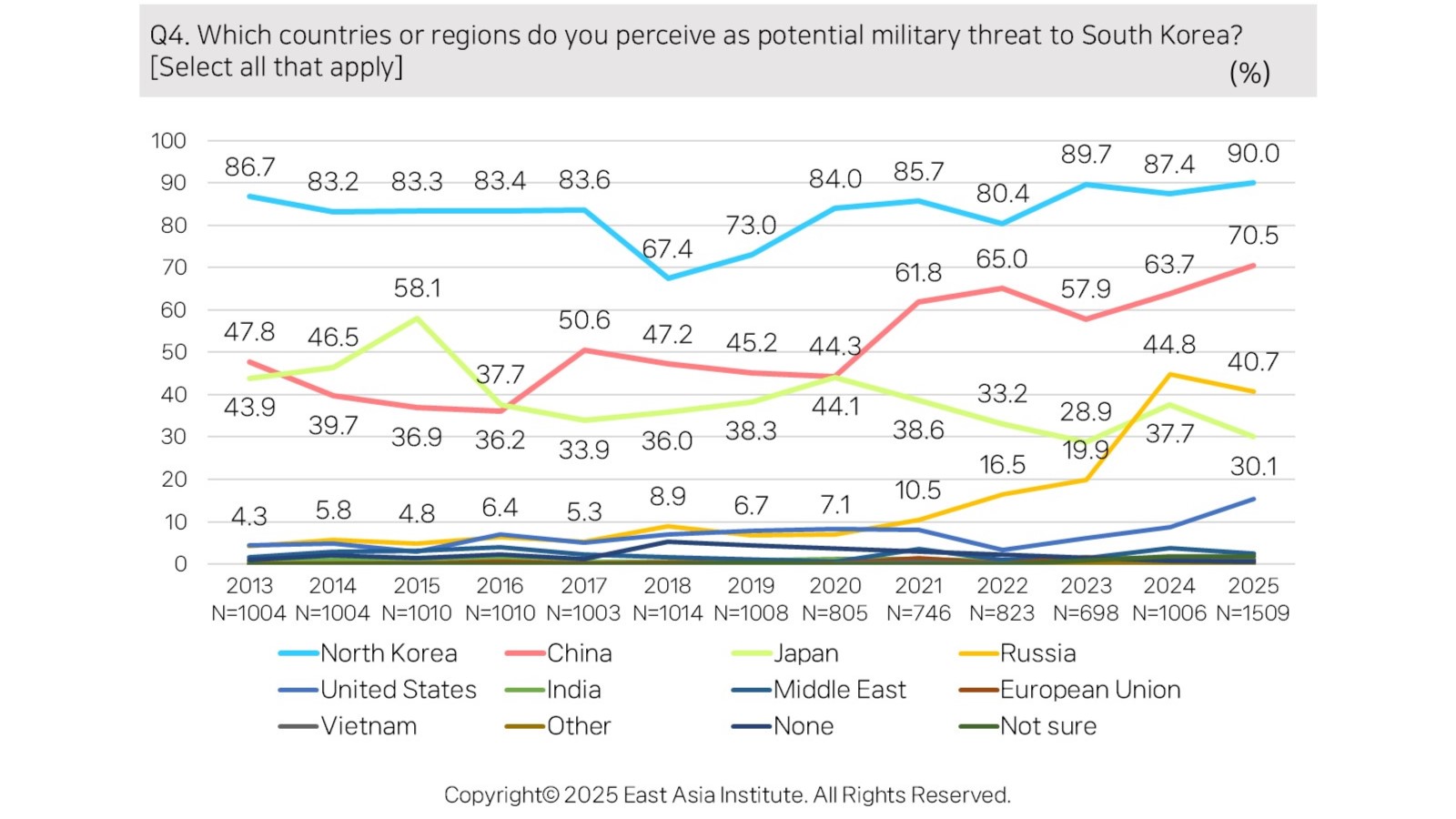
Intensifying U.S.-China competition and conflict, most particularly in trade and advanced technology domains sparked by President Trump’s tariff policies, has prompted South Korean public opinion to place heightened emphasis on the importance of the ROK-U.S. relations. This elevated perception appears to reflect both traditionally strong emphasis on relations with the U.S. and growing concerns regarding trade negotiations under the current U.S. admіnistration.
Since the Trump admіnistration’s reemergence, trust in the United States has declined from 73.1% in 2024 to 68.4% in 2025, representing a 4.7 percentage point decrease. This decline stems from more negative perceptions of President Trump (75.5%) compared to President Xi Jinping (71.7%), alongside overwhelming opposition to Trump admіnistration tariff impositions (85.6%). Particularly significant is the dramatic 45.5 percentage point increase from the previous year in respondents citing the United States’ coercive trade and tariff posture as grounds for negative impressions, which amounts to 79.9%. These dynamics suggest that growing emphasis on China’s economic relations correlates with tariff policies under the Trump admіnistration.
As economic tensions and strategic competition between the United States and China escalate, South Korean public opinion reflects heightened economic security concerns, resulting in dual recognition of both the increasing importance of the ROK-U.S. relations and the significance of economic relations with China. This is further evinced by public sentiment identifying “strengthening economic diplomacy” as a higher foreign policy priority than “strengthening the ROK-U.S. alliance,” indicating pronounced public concern with economic issues under the new admіnistration.
Simultaneously, a growing consensus has emerged regarding the need to expand ROK-U.S. alliance roles beyond the Korean Peninsula to regional and global levels from security perspectives. This trend reflects rising security concerns driven by North Korea’s intensified nuclear and missile threat as well as China’s military capability augmentation, resulting in broad recognition of the strengthened ROK-U.S. alliance as essential. Nevertheless, regarding specific issues such as the Taiwan Strait, public opinion remains cautious and reserved.
Perceptions that Taiwan Strait tensions and conflict critically impact South Korea’s national interests rose by 8.2 percentage points from the previous year, which reached 87.5%. However, when questioned about South Korea’s appropriate response to Taiwan Strait military clashes, the majority (49.3%) indicated that maximum involvement should be limited to humanitarian assistance, while the second most frequent response advocated complete non-involvement (15.8%). (Figure 16) These figures represent respective increases of 5.1 and 6.7 percentage points compared to 2024. Similarly, regarding potential U.S. Forces Korea (USFK) roles in Taiwan contingencies, most respondents supported non-direct engagement: 42.3% favored rear-area support within the Korean Peninsula, while 29.5% believed USFK should focus exclusively on South Korea’s defense. (Figure 17) Although Taiwan Strait tension concerns are increasing, public opinion prefers that South Korea’s security be prioritized and South Korea’s involvement in a Taiwan contingency be minimized. This broader sentiment is reflected in the growing proportion of respondents advocating neutrality during serious U.S.-China conflicts, rising from 46.8% in 2024 to 51.3% in 2025.
Figure 16. Response of South Korea on Taiwan Strait Conflict
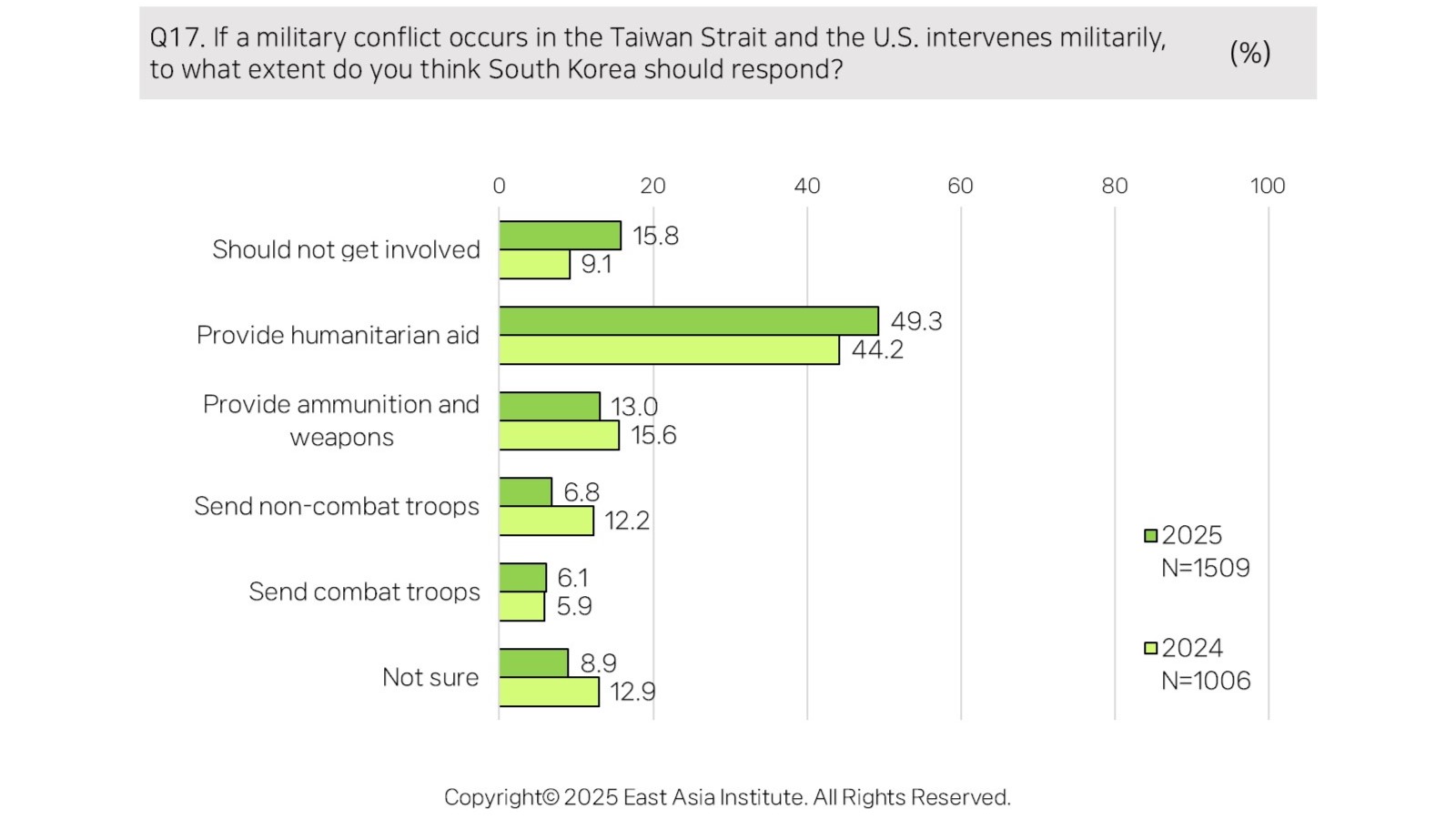
Figure 17. Role of USFK on Taiwan Strait Conflict
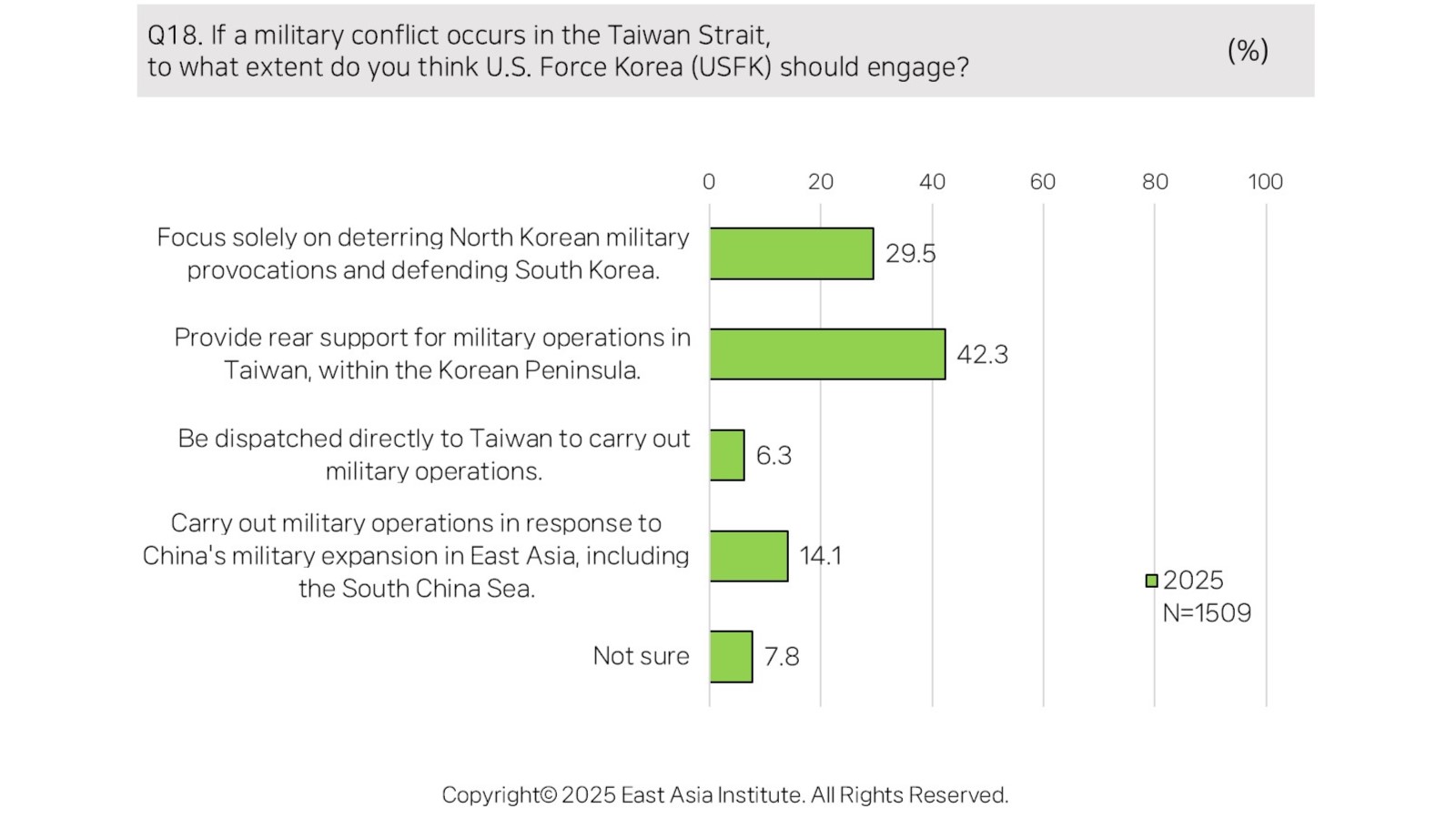
Amid growing public concern over economic issues, heightened recognition of the importance of trade negotiations’ importance with the United States extends to acknowledgment of the significance of China’s economic relations. Simultaneously, strengthening the ROK-U.S. alliance is deemed necessary to address security instability, while prevailing apprehension that involvement in the Taiwan issue may undermine South Korea’s security leads to public preference for restricting such engagement. The public thus expects the new admіnistration to craft a meticulously calibrated strategy grounded in economic pragmatism to navigate the complex, multi-variable equations of the evolving international order with foresight and prudence.
IV. Outlook and Strategic Challenges in ROK-China Relations
While public sentiment toward China remains predominantly unfavorable, prevailing consensus acknowledges that bilateral relations remain fundamentally important—particularly in economic exchange, advanced technology cooperation, and the North Korean issues—necessitating improving relations with China. Public opinion reflects pronounced conviction that revitalizing the stagnant economy and alleviating security anxieties should constitute core diplomatic priorities for the new admіnistration, a perspective equally evident in China diplomacy attitudes. Amid intensifying U.S.-China trade friction, increasing geopolitical instability and uncertainty surrounding the Korean Peninsula, the public perceives a further extension of stagnated bilateral relations with China as detrimental to South Korea’s national interests. Consequently, establishing initial breakthroughs for relationship improvement and creating conducive environments for reactivating basic exchanges and cooperation is deemed desirable. As exchanges and cooperation resume, mutual hostility and unfavorable perceptions may gradually diminish.
Despite both public expectations for improved South Korea-China relations and the new admіnistration’s willingness to achieve it, a rapid improvement appears to be realistically far-fetched. Economic competition with China is intensifying while strategic communication on North Korea has effectively ceased. With escalating U.S.-China rivalry, the expected pressure from the Trump admіnistration may prompt South Korea to participate more actively in efforts to contain China, thereby further aggravating the existing complex circumstances. Public opinion simultaneously demands that South Korea enhance the ROK-U.S. alliance and improve relations with China.
The Lee Jae Myung admіnistration thus confronts a diplomatic conundrum: responding to U.S. demands for China counterbalancing aligned with rising alliance strengthening support, while simultaneously working to rebuild relations with China despite pervasive domestic distrust. Should these efforts to improve relations with China fail to yield tangible outcomes, anti-China sentiment may intensify and become a source of political contention. Furthermore, unfavorable perceptions of China are both persistent and increasingly rooted in underlying perceptions regarding Chinese national character, behaviors, and Communist Party regime nature—factors that render the public particularly wary of perceived concessions. As a consequence, the Lee admіnistration must approach China policy with prudence and strategic sophistication, balancing it with relations involving other key actors, such as the United States and North Korea. A comprehensive, carefully calibrated, and incremental approach will prove essential. ■
■ Dong Ryul Lee is the Chair of China Research Center at East Asia Institute (EAI) and Professor at Dongduk Women’s University.
■ Translated and Edited by Inhwan Oh, Senior Research Fellow; Hansu Park, Research Associate
For inquiries: 02-2277-1683 (ext. 202) ihoh@eai.or.kr
![[EAI Issue Briefing] Expectations and Challenges for Improved Relations with “Unfavorable” China under the Lee Administration: 2025 EAI Public Opinion Poll on East Asia](/data/bbs/eng_issuebriefing/2025070114329345217651.jpg)
![[EAI Issue Briefing] The Public Prioritizes a Future-oriented Cooperation over Resolving the History Problem in Korea-Japan Relations: 2025 EAI Public Opinion Poll on East Asia](/data/bbs/eng_issuebriefing/20250627164526777359170(0).jpg)
![[EAI Issue Briefing] South Koreans’ Perceptions of Blocs between ROK-US-Japan and DPRK-China-Russia and Support for Nuclear Armament: 2025 EAI Public Opinion Poll on East Asia](/data/bbs/eng_issuebriefing/20250627104730777206122(0).png)